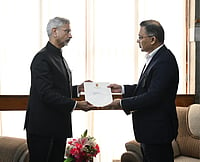India is faced with great challenges so far as advances in science and technology are concerned. But they can also be seen as profound opportunities. The current mood is one of hope with the buzzword being R&D and innovation. The National Innovation Council under Sam Pitroda is generating waves of ideas and the 12th Plan too is focused on this area. India has missed much by wasting the creative energy of our young scientists, a lasting legacy of our post-colonial bureaucratic system and the scientific illiteracy of our politicians. Even with 634 universities and 33,023 colleges imparting higher education and 1,37,668 students doing research, the contribution of R&D to our national economy is insignificant. Most of our universities and technical institutes continue to be just teaching centres, which is why our industry is still heavily dependent on borrowed technology, impeding our ability to compete in what is a highly competitive global economy.

| Illustration by Sorit |
For instance, the government is chary of giving sufficient funds to programmes like FIST (Funds for Improvement of S&T infrastructure in universities and higher educational institutions), launched some 12 years ago. In our estimated Rs 72 lakh crore economy, the allocation for this vital purpose was just Rs 128 crore in 2010-11. An incentive-based programme called Promotion of University Research & Scientific Excellence (PURSE), formulated by the department of science & technology (DST), had selected 14 varsities on the basis of published research papers; they were given a grant of a mere Rs 2-10 crore for a period of three years! Thirty more universities were identified for similar assistance last year. All this is just a drop in the ocean.
Dr A. Mukhopadhyay of the DST, however, argues that R&D allocation to universities is sufficient. He says absorbability rather than availability of funds is the major problem. Often recruitment of qualified research personnel, getting equipment, take an unduly long time!
Everyone agrees that R&D in Indian varsities is marred by rules, regulations and politics. Many professors think their role is only to teach. Even if students are inclined, they are not enthusiastic, as promotions are time-bound and not research-linked. In fact, few universities set any target for research. The question arises, who should give the incentive? Many feel the industry must get interested. The fact is, universities hardly show any awareness about industrial needs.
IIM professor Dr Anil Gupta, a renowned innovation campaigner, laments this lack of innovative attitude. As he puts it, “All engineering students are supposed to do a project in their final year. But few do it. Most of them copy some good project done by others long ago and pass it off as original work!” Thankfully, a Techpedia website launched by SRISTI, an NGO, is helping to curb such cheating. And some companies are now offering juicy projects to students to keep them interested.
Unfortunately, the AICTE and the UGC have taken a blinkered view of the welcome development. Dr Gupta strongly recommends that industry come forward to tap the immense potential of universities, and that the government gives at least 25 per cent of its total R&D funding to university-industry linked projects.
The National Innovation Council is currently working on a novel concept of ‘university innovation clusters’ which will work closely with industry clusters. Dr Gupta, though, says large-scale transformation cannot take place without improving the quality in the swarm of private institutions which have come up in the last two decades. “Teachers are the vital key—unless outstanding teachers become the hub of research, excellence in R&D will not be nurtured,” he says.
(The author is a science writer and editor of Lokayat.)


























